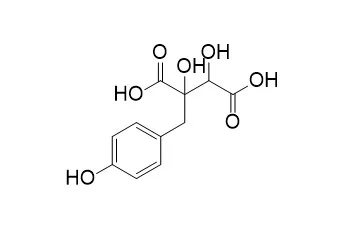| In vitro: |
| Arch Pharm Res . 2017 Nov;40(11):1278-1286. | | Isorhamnetin derivatives and piscidic acid for hypercholesterolemia: cholesterol permeability, HMG-CoA reductase inhibition, and docking studies[Pubmed: 28936788] | | Bioactive compounds, such as isorhamnetin and Piscidic acid, were obtained from decoctions of cladodes (stem pads from Opuntia ficus-indica). The effect of these phenolic compounds, in a fiber-free extract, were evaluated as inhibitors of cholesterol permeation through a Caco-2 cell monolayer and as 3-hydroxy-3-methylglutaryl coenzyme A reductase inhibitor. A reduction of 38% in cholesterol permeation through the Caco-2 cell monolayer was obtained, and the phenolic compounds all permeated between 6 and 9%. A mixture of these compounds showed an IC50 of 20.3 μg/mL as an enzyme inhibitor, whereas Piscidic acid alone showed an IC50 of 149.6 μg/mL; this was slightly outperformed by the isorhamnetin derivatives. Docking studies confirmed that both Piscidic acid and isorhamnetin derivatives, present in the decoction, could adequately bind to the enzyme active site. These results reveal that O. ficus-indica, and cladodes derived there from, is a promising plant for use in the development of new functional foods and pharmaceutical products. | | Molecules . 2021 Sep 24;26(19):5800. | | Bio-Guided Fractionation of Retama raetam (Forssk.) Webb & Berthel Polar Extracts[Pubmed: 34641345] | | The fractionation of the methanolic extract (MeOH-E) of Retama raetam (Forssk.) Webb & Berthel and further analysis by thin layer chromatography resulted in four fractions (F1, F2, F3 and F4) that, in parallel with the MeOH-E, were screened for antioxidant, cytotoxic, antidiabetic and antibacterial properties. In addition, chemical characterization of their bioactive molecules was performed using LC-DAD-ESI/MSn. The results indicated that F3 was the most promising regarding antioxidant and cytotoxicity abilities, possibly due to its richness in flavonoids class, particularly isoflavones. In turn, F1 was characterized by the presence of the most polar compounds from MeOH-E (organic acids and Piscidic acid) and showed promising abilities to inhibit α-amylase, while F4, which contained prenylated flavonoids and furanoflavonoids, was the most active against the tested bacteria. The gathered results emphasize the distinct biological potentials of purified fractions of Retama raetam. | | Molecules . 2020 May 6;25(9):2176. | | Characterization of Micronutrients, Bioaccessibility and Antioxidant Activity of Prickly Pear Cladodes as Functional Ingredient[Pubmed: 32384787] | | The Opuntia ficus indica (L.) (OFI) is used as a nutritional and pharmaceutical agent in various dietary and value added products. This study underlines the possible use of native prickly pear cladode powder as a functional ingredient for health-promoting food production. To summarise, chemical characterization of polyphenols, minerals and soluble dietary fibre was performed; furthermore, the antioxidant activity and bioaccessibility of polyphenols and minerals were assessed. Eleven compounds between phenolic acids and flavonoids were identified, with Piscidic acid and isorhamnetin derivatives being the most abundant. Opuntia's dietary fibre was mainly constituted of mucilage and pectin, and was composed of arabinose, galactose, glucose, mannose, rhamnose, and xylose sugars. The polyphenols' bioaccessibility was very high: Piscidic acid at 200%, eucomic and ferulic acids >110% and flavonoids from 89% to 100%. The prickly pear cladode powder is also a source of minerals, as cations (calcium, sodium, potassium and magnesium) and anions (sulphate and chloride), with high magnesium bioaccessibilty (93%). OFI powder showed good capacity of radical scavenging measured by DPPH and ABTS methods, with 740 and 775 μmol Trolox/100 g OFI, respectively. Finally, the presented results allow the consideration of this natural product as a source of several essential nutrients, with a possible use in the food industry as a functional ingredient. | | Foods . 2021 Mar 9;10(3):570. | | Emergent Technologies for the Extraction of Antioxidants from Prickly Pear Peel and Their Antimicrobial Activity[Pubmed: 33803279] | | Phenolic compounds are important bioactive compounds identified in prickly pear peel that have important antioxidant and antimicrobial properties. However, conventional thermal extraction methods may reduce their bioactivity, and technologies such as high pressure (HP) and ohmic heating (OH) may help preserve them. In this study, both technologies were analyzed, individually and combined (250/500 MPa; 40/70 °C; ethanol concentration 30/70%), and compared with Soxhlet with regard to total phenolics, flavonoids, and carotenoids as well as antioxidant (ABTS, DPPH, ORAC), DNA pro-oxidant, and antimicrobial (inhibition halos, minimum inhibitory concentration (MIC), minimum bactericidal concentration (MBC), growth curves, and viable cells) activities of prickly pear peel extracts. Total phenolics extracted by each technology increased 103% (OH) and 98% (HP) with regard to Soxhlet, but the contents of total flavonoids and carotenoids were similar. Antioxidant activity increased with HP and OH (between 35% and 63%), and OH (70 °C) did not induce DNA degradation. The phenolic compound present in higher amounts was Piscidic acid, followed by eucomic acid and citrate. In general, their extraction was significantly favored by HP and OH. Antimicrobial activity against 7 types of bacteria showed effective results only against S. aureus, S. enteritidis, and B. cereus. No synergetic or additive effect was observed for HP/OH. |
|






 Cell. 2018 Jan 11;172(1-2):249-261.e12. doi: 10.1016/j.cell.2017.12.019.IF=36.216(2019)
Cell. 2018 Jan 11;172(1-2):249-261.e12. doi: 10.1016/j.cell.2017.12.019.IF=36.216(2019) Cell Metab. 2020 Mar 3;31(3):534-548.e5. doi: 10.1016/j.cmet.2020.01.002.IF=22.415(2019)
Cell Metab. 2020 Mar 3;31(3):534-548.e5. doi: 10.1016/j.cmet.2020.01.002.IF=22.415(2019) Mol Cell. 2017 Nov 16;68(4):673-685.e6. doi: 10.1016/j.molcel.2017.10.022.IF=14.548(2019)
Mol Cell. 2017 Nov 16;68(4):673-685.e6. doi: 10.1016/j.molcel.2017.10.022.IF=14.548(2019)